|
 Descolea gunnii Descolea gunnii
SynonymsGymnoglossum gunnii
Descolea squarrosipes
Secotium gunnii
BiostatusPresent in region - Indigenous. Non endemic
Images (click to enlarge)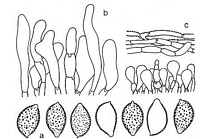
Caption: Fig. 7. Descolea gunnii. - a. Spores (2000 X ). - b. Cheilocystidia (1000 X ). - c. Cuticle
(500 X ). | 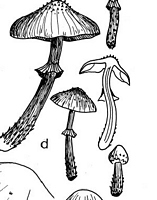
Caption: Descolea gunnii -Figs 2d | 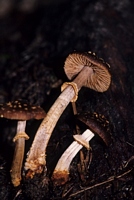
Owner: Herb. PDD | 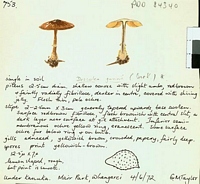
Caption: water colour
Owner: G.M. Taylor | 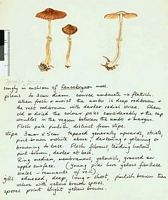
Caption: Watercolour
Owner: G.M. Taylor | 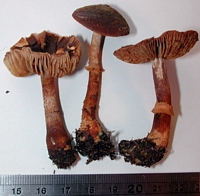
Caption: fruitbody
Owner: J.A. Cooper | 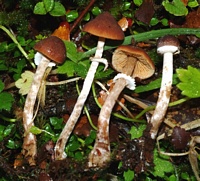
Owner: J.A. Cooper | 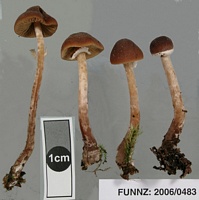
Owner: J.A. Cooper | 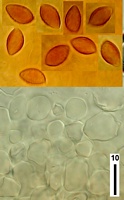
Caption: spores and cap cuticle.
Owner: J.A. Cooper | 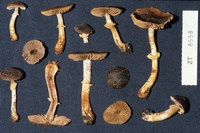
Caption: ZT8558
Owner: E. Horak: © Creative Commons Attribution-Noncommercial 3.0 New Zealand | 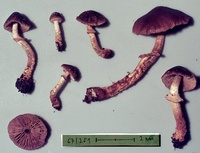
Caption: ZT67-251
Owner: E. Horak: © Creative Commons Attribution-Noncommercial 3.0 New Zealand | 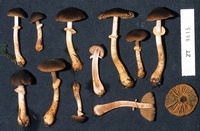
Caption: ZT9615
Owner: E. Horak: © Creative Commons Attribution-Noncommercial 3.0 New Zealand | 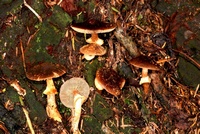
Owner: J.A. Cooper | 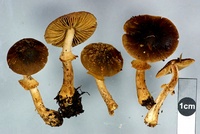
Owner: J.A. Cooper | 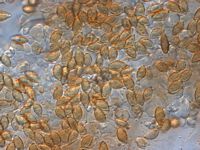
Owner: Herb PDD | 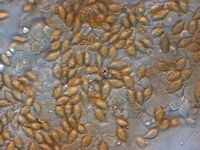
Owner: Herb PDD | 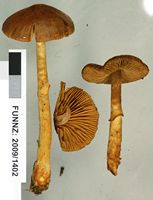
Owner: J.A. Cooper | 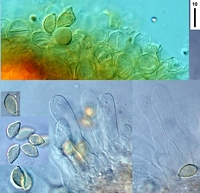
Caption: uppre cellular cuticle, lower spores and cheilocystidia.
Owner: J.A. Cooper | 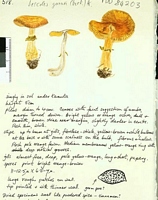
Caption: Watercolour
Owner: G.M. Taylor | 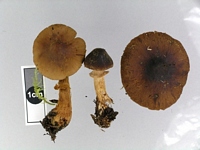
Owner: J.A. Cooper | 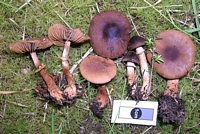
Owner: J.A. Cooper | 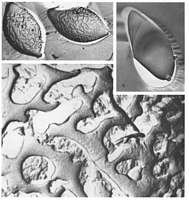
Caption: Plate 23. Cortinariaceae: 3, Descolea squarrosipes x 4375 5, Descolea squarrosipes x
36000. Detail of wall ornamentation. |
Article: Horak, E. (1980). New and remarkable Hymenomycetes from tropical forests in Indonesia (Java) and Australasia. Sydowia 33: 39-63.
Habitat: Habitat. - On soil in forests. - New Zealand (type), Papua New Guinea (under Nothofagus
grandis, N. carrii).
Notes: This species is common in New Zealand where it is encountered under various ecologic
conditions in coastal and submontane forests. D. gunnii (BERK.) occurs both in
Leptospermum spp. and Nothofagus spp. forests and it is suspected to enter at least
facultative ectotrophic mycorrhiza with those trees.
Knowing the wide ecologic range and adaptability of this agaric its presence in the
Nothofagus forests of Papua New Guinea was no great surprise. That record enlarges the
area of distribution from New Zealand to Papua New Guinea.
D. gunnii (BERK.) is closely related to D. recedens (COOKE & MASSEE) SINGER (cf.
HORAK 1971 b : 241) until recently only recorded from its type locality in Australia
(Mordiallac - now a suburb of Melbourne, Victoria). In 1977 WATLING observed this
species in several places in New South Wales and Queensland and it appears now that D.
recedens (COOKE & MASSEE) is a well established agaric in the forests of eastern and
south-eastern Australia.
Article: Horak, E. (1971). Studies on the genus Descolea. Persoonia 6(2): 231-248.
Description: Pileus 10-45 mm diam., hemispherical when young, later becoming convex or umbonate and
expanded; dark (date) brown, sometimes even umber brown but also becoming ochraceous in old
fruiting bodies; always striate near the margin, hygrophanous, dry, densely and permanently
covered by appressed fibrillose squamules of rusty or dark ochraceous colour. Lamellae (L 10-18,
1 3) adnate or emarginate-adnexed; argillaceous, turning brown, sometimes with whitish serrulate
gill edge. Stipe 15-60 X 1.5-7 mm, cylindrical, when old often subclavate, fistulose; dry, apically
whitish and farinaceous, below the striate, permanent, submobile ring (sometimes attached near
the base) densely covered with squarrose, upwards pointed, ochraceous or golden yellow scales
from the velum universale. Context brown, not gelatinous. Smell and taste not distinctive. Spores
9.5-12 X 6-7 µ, sublimoniform, verrucose with smooth mucro, isolated warts embedded in
brownish perispore, without particular plage, germ pore absent. Basidia 30-38 X 10 µ, 4-spored,
Cheilocystidia 30-60 X 7-13 µ, cylindrical or fusoid, thin-walled, forming a sterile zone at the gill
edge. Cuticle consisting of clavate cells, 12-40 X 8-20 µ, forming an epithelium; hyphae thin-walled, strongly encrusted with brown pigment, not gelatinized. Hyphae of the velum universale
cylindrical, thin-walled, encrusted, with clamp-connections.
Habitat: HABITAT: on soil or on rotten wood in forests (various species of Nothofagus,
Leptospermum, etc.). New Zealand.
Notes: This species occurs frequently in all kinds of forests in New Zealand, probably forming a
facultative mycorrhizal association with species of Nothofagus and Leptospermum as well.
Secotium gunnii Berkeley, as the examination of the type specimen showed, undoubtedly
belongs to Descolea. The spores observed are characteristic and fragments of the obviously
striate ring can still be seen in the poorly preserved collection.
Article: Pegler, D.N.; Young, T.W.K. (1971). Basidiospore morphology in the Agaricales. Beihefte zur Nova Hedwigia 35: 210 p.
Description: Descolea squarrosipes Horak ined. (Pl. 23/3,5)
New Zealand, S. Island, Springs Junction, 5.12.67, Horak 67/208 (type). The spores are amygdaliform and measure 9-11.5 x 5-6.5 µ. Carbon replicas reveal a low reticulate
ornamentation covering most of the spore surface, except for the attenuated apex and the
base. The hilar structure is of the open-pore type.
Article: Cunningham, G.H. (1924). A critical revision of the Australian and New Zealand species of the genus Secotium. Proceedings of the Linnean Society of New South Wales 49(2): 97-119.
Description: Peridium pallid brown, depressed-globose, base deeply excavated, truncate, 1.5 cm. diam.,
smooth; drying dingy-brown, rugulose. Stipe short, 1-1.5 cm. long, 2-4 mm. thick, slender,
equal, or slightly thickened downwards, solid, pallid-brown; columella expanded at the apex.
Gleba ferruginous, cellular, cells minutely polygonal, 1 mm. long, dissepiments thin. Spores
minutely verruculose, broadly elliptical, pallid ferruginous, one end bluntly rounded, the other
apiculate, 6-8 x 4-5 µ (Massee, 7 x 4 µ), epispore thin. Habitat.-Solitary on the ground.
Notes: The smooth peridium, short, solid stipe and small, rough spores characterise this species. It is
separated from the preceding principally on account of the short stipe and the small size of the
spores.
In the original description the spores are stated to be smooth, but I find them to be minutely but
distinctly verruculose. This character varies somewhat in individual plants, for, of the two plants
in my possession, one exhibits more pronounced markings than does the other.
Lloyd (1905) states that he believes this to be a synonym of S. coaretatum; but examination will
show that both in glebal and spore characters it is decidedly different.
I am indebted to Mr. Rodway for the donation of two specimens of this species, now in my
herbarium, No. 1203. The question may be raised as to whether the material I have examined is
that of S. Gunnii, but I am assured by Mr. Rodway that these specimens are from a collection
determined by Massee himself.
|